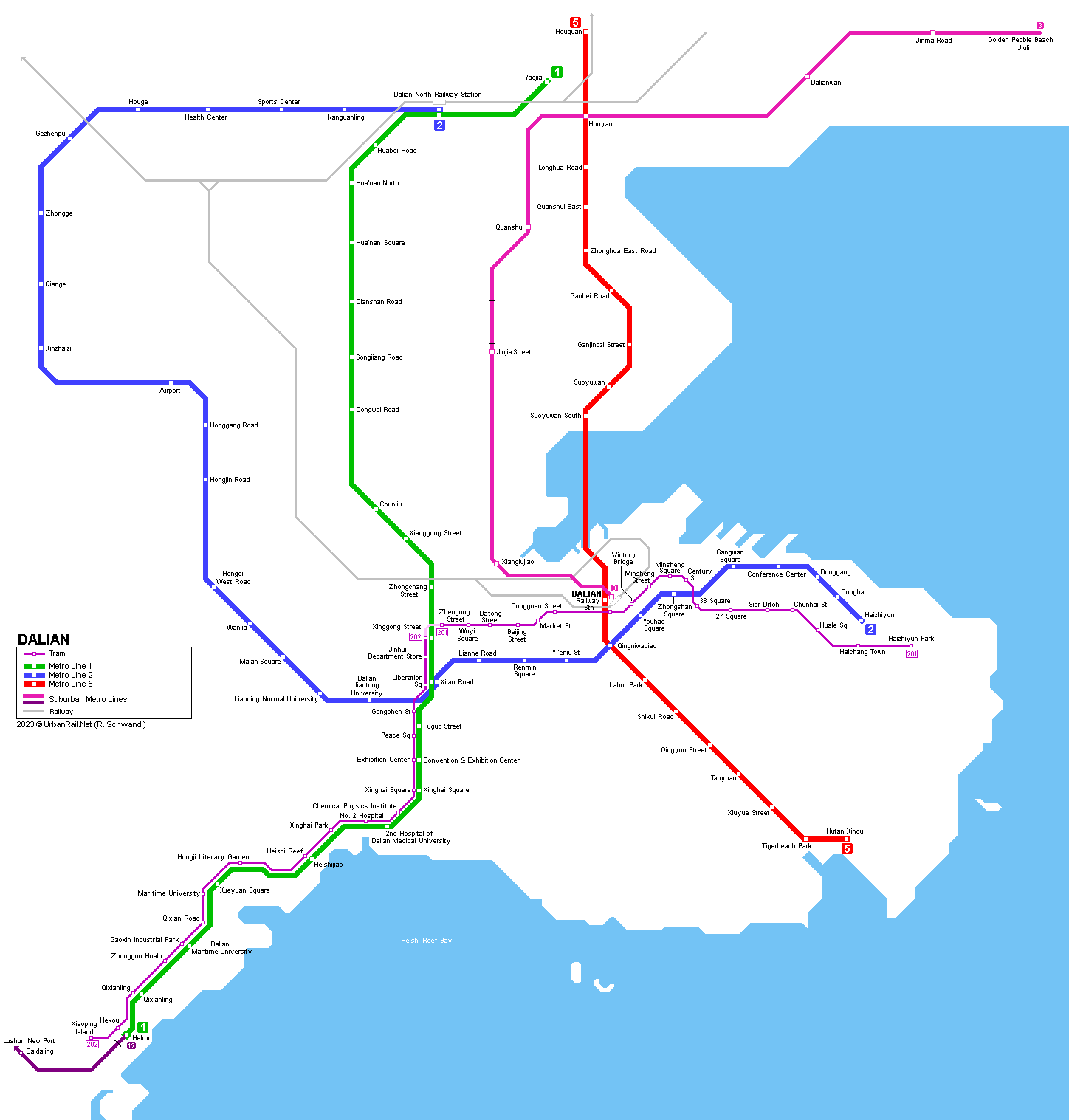
|
[ UrbanRail.Net ] [ Europe ] [ Americas ] [ Asia ] [ Africa ] [ Oceania ] [ News ] [ Books ] [ Links ] |
|
DALIAN
|
| China |
Click on map to view suburban lines!
|
METRO
|
|
Dalian is located in northeast China, in the province of Liaoning and has some 3.2 mill inhabitants in the urban area, and an estimated 6.2 mill. in the metropolitan area. Besides several modern metro lines, Dalian also boasts historic streetcars, as well as a modern light rail line.
|
| Line 1 |
| 30 Oct 2015:
Yaojia - Fuguo Street (16.5 km) 29 Jan 2016: Fuguo Street - Convention & Exhibition Center (1.2 km) 01 June 2017: Hua'nan North station 07 June 2017: Convention & Exhibition Center - Hekou (9.1 km) |
|
|
| Line 2 |
| 30 Apr 2015:
Dalian Airport - Conference Center (18.9 km) 07 June 2017: Conference Center - Haizhiyun (3.8 km) 28 June 2018: Dalian Airport - Xinzhaizi 30 Sept 2022: Xinzhaizi – Dalian North Railway Station (12.2 km) |
|
|
| Line 5 |
|
17 Mar 2023:
Houguan - Hutan Xinqu (24.5 km)
|
|
|
| Suburban Line 3 |
|
The city's first rapid rail transit line, known as Qinggui Line, connects Dalian Development Zone and Jinshitan with Dalian city centre. The line is 49 km long, but has only 12 stations (with two more planned). Each train has 176 seats and runs at an average speed of 60km/h, with a maximum speed of 100 km/h. Route: Dalian Railway Station --> Xiang Lu Jiao --> Jinjia Street --> Quan Shui --> Hou Yan --> Dalian Bay --> Jin Ma Rd --> Kaifaqu (Development Zone) --> Free Trade Zone --> DD Port --> Xiao Yao Bay --> Golden Pebble Beach A branch line was added in Dec. 2008, covering a total length of 14.3 km with 6 stations, a branch previously known as Line 7. 01 May 2003:
Dalian Railway Station - Golden Pebble Beach (Jin Shi Tan) |
|
|
| Suburban Line 12 |
|
At the end of 2013, Line 12 opened as a rapid transit line that links Dalian with the western settlements on Liaodong Peninsula. In June 2017 it was eventually linked to the rest of the rapid transit network at Hekou. 30 Dec 2013:
Caidaling - Lushun New Port (Lüshunxingang) (40.4 km)
|
|
|
| Suburban Line 13 |
|
Suburban line heading north as the logical extension of the Jiuli branch of the existing line 3, offering through service Line 3/13, but requiring a transfer to main line 3 branch at Dalian Development Zone (see map): 28 Dec 2021: Jiuli – Pulandian Zhenxing Street (43 km)
|
|
|
|
Photos
|
|
Links
|
|
Dalian Metro (Official website) Dalian Metro at Wikipedia
|
|
Dalian
Tram
|

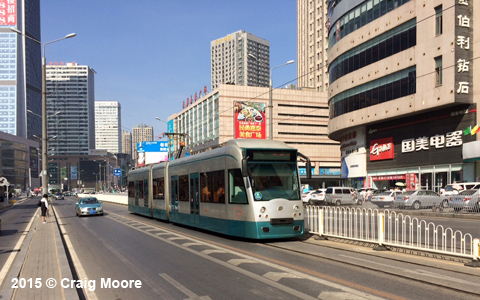


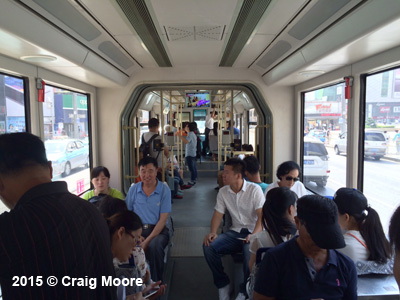
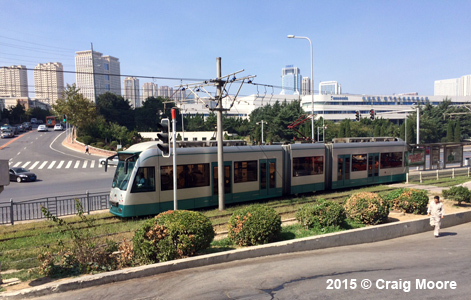
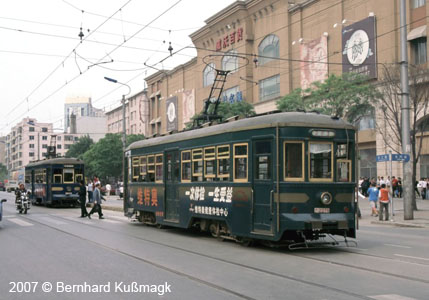
 |
| Report |
|
In April 2017, Craig Moore sends his views on Dalian: Like several cities in East Asia, Dalian has an urban rail system with mixed ownership. Unlike most, though, the systems here are both physically, and ‘corporately’ separate with no integration of any kind. In Dalian, this is mainly a temporal and geographic issue rather than any planned isolation. The city was one of the earlier Chinese cities to venture into urban rail with the Quinggiu Line (No. 3/7 on the map above) opening in 2003. This is a suburban metro line operated by Dalian Public Transport Group (DPTG) and it (and its subsequent branch (2008)) came 12 years before the full metro (see below). The line runs from the terminus at the northern square of Dalian Railways station. Heading north through the city it passes the docks and inner city (great views) before turning east along the southern shore of the promontory to Jinshitian (Golden Pebble Beach). With the exception of 1.2km of underground line, it is elevated and at grade, running 49.2km (14 stations) (48.7km revenue track) from 0630-1900 at 10min headways. The 2008 northern branch (Line 7) from Kaifaqu to Jiuli is 14.3km (6 stations) (13.8km revenue track). Both lines cover the expanding built-up area to the northeast of Dalian and run 4-car CNR stock (two varieties) with a mix of side and single facing seats. The interior of this stock is a little grubby now but offers much standing space for the heavily used routes and has an electronic strip map and audio announcements in Chinese and English. It’s a far cry from the newer LCD/Dynamic offer on new stock in China and shows just how far the place has come. The main railway station is located in the traditional centre of the city and the metro station is a large, elevated bold structure, with a rather cramped and confusing interior full of angled banks of ticket barriers, criss-crossing escalators and personal offices. There is a large geographic map and basic green ‘dot’ schematic but no hard-copy information, timetable information or RTI. Ticket machines are easy to use and dispense RFID cards with distance-based fares ranging from 1-8 Yuan. The platform level has no niceties but it shows off the arched roof and provides great views of the skyscrapers of the new city centre and the trams meandering along the streets (see below). The platform here is a central island platform and two exterior side platforms with trains pulling in on either track and passengers alighting and joining from separate platforms. These are well used, especially at peak hour when movements are every 3/4mins and passenger volumes high. Drivers are waiting at the end of the platform to take the next train out as soon as it arrives and turnaround is only 2mins. Stations along the route have island platforms and a lower level entrance/ticket hall. These again are very basic with no RTI and just the simple schematic. At several stations approaching Dalian there are ‘pushers’ employed, and the calmness and politeness and efficiency of passengers is a joy to witness. What a great line, and more than can be said for the full metro. 8mins walk from the Dalian terminus (crossing the tram lines - see below) is Youhao Guangzhang Metro station, the nearest connection between the two systems. The Dalian Metro is a 2-line, fully underground system (36.3km/30 stations) and has opened at different stages of 2015, Line 2 being the first. It runs in a bowl shape from Zhoushuizi International Airport in the northwest to the Conference Centre in the new city centre. The line operates from 0630-2200 and is 18.9km with 17 stations and takes 37mins to travel (10min base headways). The airport station is outside the terminal to the right but is only a 2min walk once you have left the building. Other stations have totems, and standard entrance porticos at main junctions. The stations on this line are quite modest. Standard rectangular ticket halls with security, customer office, ticket machines and directional signs. There is no mappage at all apart from a fare map. The island platforms are equally Spartan with three quarter screens, topped with slats, tinted windows and a blue strip to match line colour (all strip maps and directional signs have been future-proofed to include line extensions to be opened to 2018). There is RTI and audio announcements but the offer is pretty basic. The 6-car CNR stock is clean and bright white with white side seating – any colour coming from an information poster in blue (green on Line 1) and a blue electronic strip map above the door (there is no system map on the train or at stations!!!). At Xianlu there is transfer to Line 1 whose platforms are above Line 2 and travel in the same direction. Transfer is very easy and well signed. Line 1 has many of the attributes of Line 2, with identical stock (except for poster colour), and the stations are very similar also, although the general ambience is more stylised. The 17.4km line has 14 stations with the same operating hours and frequencies as Line 2 as it runs in a north-south direction from Yaojia to the sparkling Exhibition Centre (with connection to the light rail - see below). The line also stops at North Railway Station and Xinggong Street I, the heart of the commercial city. The entire journey takes 34mins. Tickets come in the form of colourful cards and fares are distance-based (2-6 Yuan). Staff are helpful and there are some stations which provide ‘user guides’ offering a crude schematic. But in most cases these are not available. For a contemporary feel and clean bright surroundings, the full metro is fine, but it has none of the character of the original line. Given the city’s’ Russian and Japanese heritage it is no surprise that trams rattle along the streets. Although a far cry from its heyday in the 1950s, the network is still of interest with 2 interconnected routes. Route 201 serves the city centre, with street running from Haizhiyun Park – Xinggong Jie (via Dalian Rail Station) (10.8km). The line is slow, with plentiful traffic conflict and uses a mix of heritage trams (Japanese built Dalian 3000s) and more modern Dalian 6WA units. At Xinggong Jie there is transfer to Route 202. Although initially a tram route, it went through modernisation in 2002 and can now be classed as a light rail in many respects. Street running in the main commercial area soon gives way to full segregation and even an elevated section on its 12.6km run to the south west at Qixianling. This is an interesting route and a flat fare of 1 yuan applies which is dropped in a box located next to the surly conductress/driver (they swap roles at the terminus) (Note that the tram company in Dalian employs only females). This line, and many of the trams on 201 are the low-floor 6WAs designed by the Dalian tram works, although clearly ‘inspired’ by the Siemens Combino. Trams run at 10min headways on this route and the line will eventually reach Xiaopingdao where it will connect to the DPTG Line 8 suburban line to Lüshunxingang on the western tip of the peninsular. Download May 2018 update here (PDF)!
|

2007 © Robert Schwandl (UrbanRail.Net)